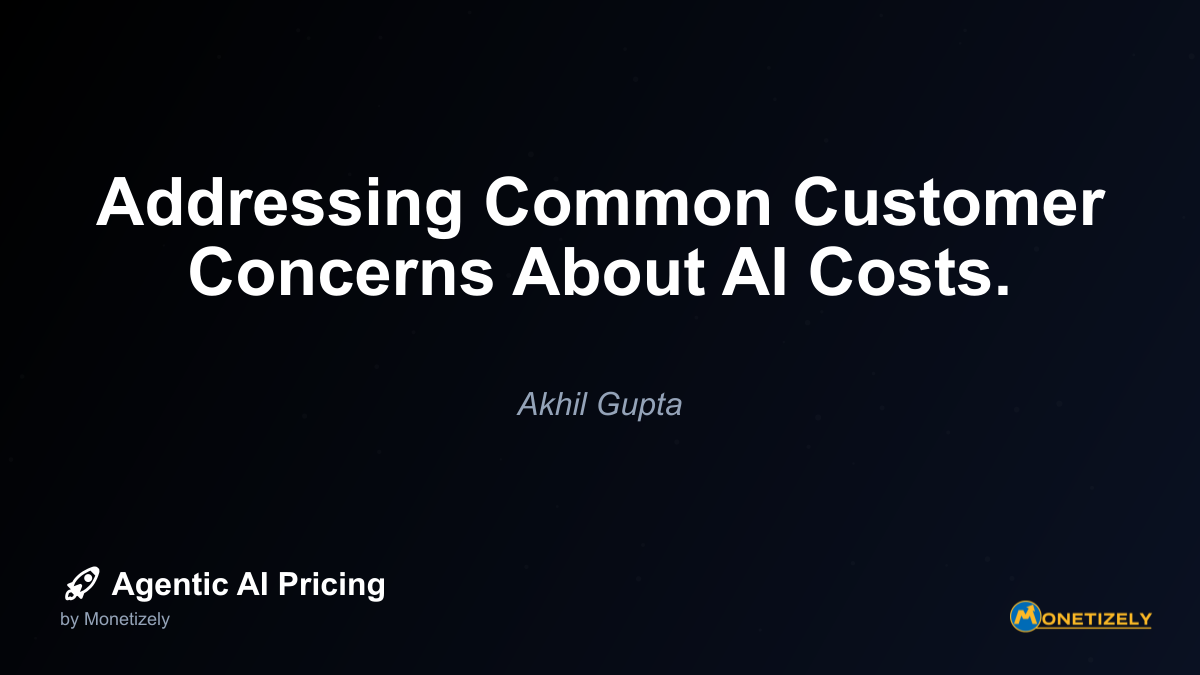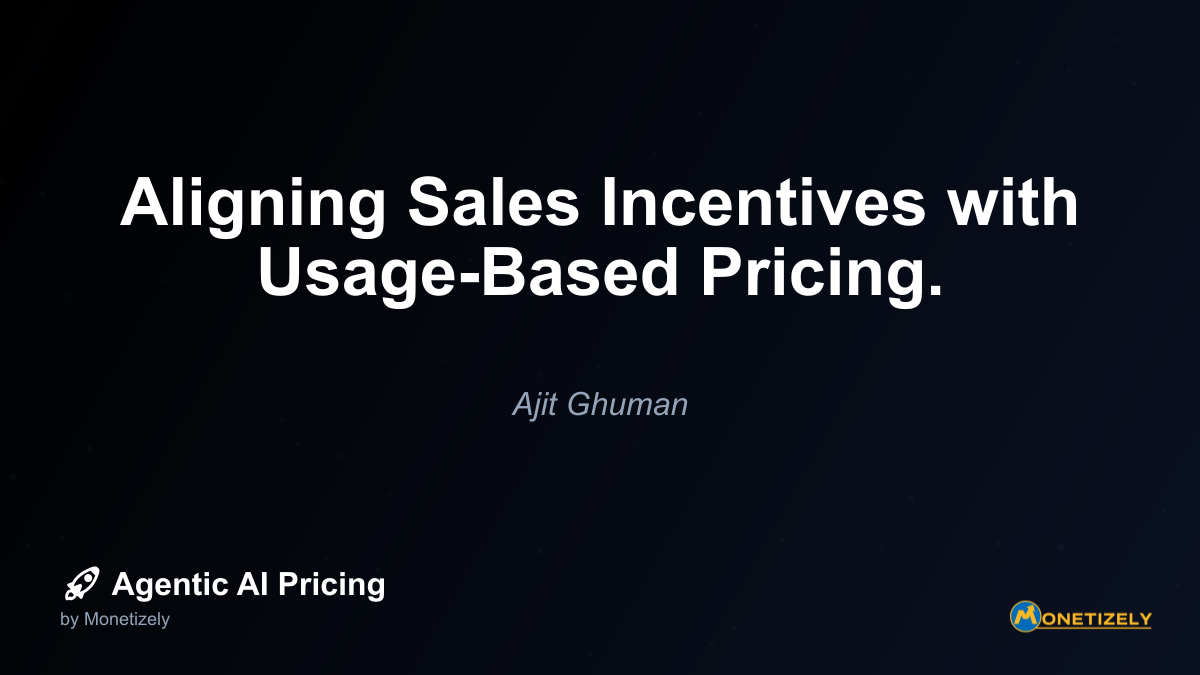· Akhil Gupta · Best Practices · 6 min read
Training Your Sales Team on New AI Pricing Models.
AI and SaaS Pricing Masterclass
Learn the art of strategic pricing directly from industry experts. Our comprehensive course provides frameworks and methodologies for optimizing your pricing strategy in the evolving AI landscape. Earn a professional certification that can be imported directly to your LinkedIn profile.

Measuring Training Effectiveness
To ensure your sales training for AI pricing models delivers results, implement specific measurement approaches:
Knowledge Assessment
Regularly evaluate team understanding through:
- Scenario-based quizzes that test application rather than memorization
- Pricing calculation exercises with diverse customer profiles
- Recorded mock presentations evaluated against standard criteria
- Peer review sessions where representatives critique each other
These assessments should identify both individual and team-wide knowledge gaps.
Field Observation
Direct observation provides valuable insights into real-world application:
- Sales managers should join customer calls specifically to evaluate pricing discussions
- Record (with permission) actual customer conversations for review
- Use post-call debriefs to provide immediate feedback on pricing explanations
- Track which materials or approaches are being used in actual sales situations
Customer Feedback
Systematically gather prospect and customer input on the sales experience:
- Survey new customers about their understanding of the pricing model
- Ask for specific feedback on the clarity of pricing explanations
- Identify any lingering questions or concerns about the model
- Track whether expectations set during sales align with actual experience
“We started asking new customers to explain our pricing model back to us in their own words,” shares Deepa Patel, Customer Success Director at an AI workflow company. “It quickly highlighted where our sales team was creating confusion versus clarity.”
Performance Metrics
Establish specific KPIs to measure the impact of your training:
- Close rates for different pricing models
- Average sales cycle length by pricing approach
- Discount frequency and magnitude
- Customer retention rates by pricing model
- Expansion revenue within accounts using new pricing structures
Track these metrics before and after training initiatives to measure impact.
Specialized Training for Different Sales Roles
Different members of your sales organization have distinct needs when it comes to AI pricing training:
Sales Development Representatives (SDRs)
Focus training on:
- Initial qualification questions related to usage patterns
- Simple explanations that generate interest without overwhelming detail
- Addressing early objections that might prevent further conversation
- Identifying prospects most likely to benefit from your pricing model
SDRs need enough understanding to generate qualified interest but should avoid detailed pricing discussions best handled by account executives.
Account Executives (AEs)
Provide comprehensive training on:
- Detailed model mechanics and calculation methodologies
- Customized ROI analysis for specific customer situations
- Negotiation strategies that preserve model integrity
- Competitive positioning against various pricing approaches
- Cross-selling and upselling within the model framework
AEs require the deepest understanding as they’ll handle the most detailed customer discussions.
Sales Engineers
Equip with specialized knowledge of:
- Technical implementation requirements for usage tracking
- Integration points with customer systems for outcome measurement
- Data security and privacy considerations for usage-based models
- Custom reporting capabilities for consumption visibility
- Technical limitations and edge cases in the pricing model
Sales engineers often need to address the “how” questions that arise once customers understand the basic model.
Customer Success Managers
Though post-sale, these team members need training on:
- Ongoing optimization of customer value within the pricing model
- Early identification of accounts that may be surprised by costs
- Expansion strategies aligned with the pricing approach
- Usage pattern analysis for proactive recommendations
- Renewal strategies specific to the pricing model
Customer success plays a crucial role in validating the value promises made during the sales process.
Implementing Your Training Program
When rolling out AI pricing model training, consider this implementation approach:
Phase 1: Leadership Alignment
Before training the broader team:
- Ensure sales leadership fully understands and supports the new pricing
- Address concerns or resistance at the management level
- Develop clear messaging about why the change benefits customers
- Establish performance expectations during the transition period
Without leadership alignment, representatives will receive mixed messages about the importance of adopting new approaches.
Phase 2: Pilot Group Training
Start with a small group of high-performers:
- Provide intensive training on the new model
- Support their early customer conversations closely
- Document successful approaches and challenges
- Refine training materials based on their experience
This pilot group becomes internal champions who can help train others.
Phase 3: Full Team Rollout
Expand to the entire sales organization with:
- Structured training sessions covering all aspects of the model
- Hands-on workshops for practical application
- Access to refined tools and resources
- Clear guidelines for transitioning existing opportunities
- Ongoing support mechanisms for questions and challenges
Consider certification requirements before representatives can sell using the new model.
Phase 4: Continuous Improvement
Establish ongoing processes for:
- Regular refresher training incorporating new insights
- Updating materials based on customer feedback
- Sharing best practices across the organization
- Addressing emerging competitive challenges
- Adapting to any refinements in the pricing model itself
Balancing Complexity and Simplicity
Perhaps the greatest challenge in training sales teams on AI pricing models is finding the right balance between accuracy and simplicity. Representatives need enough understanding to explain the model confidently but must avoid overwhelming customers with unnecessary complexity.
Effective training helps sales teams develop a layered approach:
- Start with simple conceptual explanations focused on value
- Provide additional detail as customer interest and understanding grows
- Use visual tools to illustrate rather than explain complex concepts
- Anchor explanations in customer-specific examples
- Adjust technical depth based on the audience’s sophistication
“We train our team to explain our AI pricing in three ways,” notes Jordan Williams, Chief Revenue Officer at a leading AI platform. “The elevator pitch version takes 30 seconds and focuses purely on business outcomes. The executive summary takes five minutes and introduces the basic mechanics. The detailed explanation, which we only use when customers specifically request it, covers all the technical aspects.”
Conclusion
As AI solutions continue to transform business capabilities, the pricing models that monetize these innovations must evolve as well. Traditional fixed subscription approaches often fail to capture the variable value these systems deliver. However, implementing more sophisticated pricing requires more sophisticated sales approaches.
Investing in comprehensive sales training for AI pricing models isn’t optional—it’s essential for market success. When representatives thoroughly understand these models, can confidently explain them to prospects, and effectively address concerns, they transform potential pricing complexity from a barrier into a competitive advantage.
Organizations that excel at this training see multiple benefits beyond increased sales effectiveness. Well-trained teams set appropriate customer expectations, leading to higher satisfaction and retention. They negotiate more effectively, maintaining pricing integrity and margins. Perhaps most importantly, they position your company as a trusted advisor rather than just another vendor.
As you develop your training program, remember that the goal isn’t just knowledge transfer—it’s behavior change. Representatives need practice, feedback, and reinforcement to confidently navigate these new pricing conversations. With the right training approach, your sales team will not only adapt to AI pricing models but thrive in selling them.
For sales leaders navigating this transition, the investment in comprehensive training pays dividends through faster sales cycles, higher close rates, and stronger customer relationships built on clear value alignment from the very first conversation.
Co-Founder & COO
Akhil is an Engineering leader with over 16+ years of experience in building, managing and scaling web-scale, high throughput enterprise applications and teams. He has worked with and led technology teams at FabAlley, BuildSupply and Healthians. He is a graduate from Delhi College of Engineering and UC Berkeley certified CTO.
Pricing Strategy Audit
Let our experts analyze your current pricing strategy and identify opportunities for improvement. Our data-driven assessment will help you unlock untapped revenue potential and optimize your AI pricing approach.




